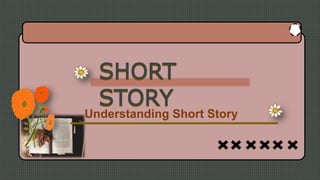
SHORT STORY.pptx
- 2. Short Story It is a fictional narrative prose that can be read in one sitting. It is also re-creation and reconstruction of life.
- 3. Short Story It also presents human life in two levels: 1. The world of objective reality made up of human actions and experiences 2. The world of subjective reality dealing with human apprehensions and comprehensions.
- 4. The plot is the sequence of the actions and events in a story to convey a theme. It is the skeleton or the blueprint of a story. The following terms explain what happens in a plot. Elements of a Short Story 1. Plot
- 5. a) Exposition (Introduction)-This comes at the beginning of the story. b.) Rising Action (Complication) – The struggle grows strong. c.) Climax- The most exciting part in the story.
- 6. d.) Falling Action - Events moves towards the end of the story. e.) Resolution- (Denouement)- The study is brought to an end.
- 7. Kinds of plot a.) Man in Hole b.) Man on a Road c. Man in a Tub
- 8. Man in the tub involves two steps: First a straightforward, constructed, usually commonplace event; and Then a flash of realization form the skeleton of a plot.
- 9. Devices in Plot a.) Chronological Arrangement - It starts from the beginning of the events. c.) Flashback - Past events are shown to justify the conflict at present. b.) In Medias Res - This starts at the middle of the story.
- 10. Devices in Plot d.) Foreshadowing - The author present in significant events and details of the presents to take on value by being indicators of future events. e.) Stream of Consciousness. A continuous and random flow of ideas, feelings, sensations, associations and perceptions as they registered on the protagonist’s consciousness
- 11. 2. Conflict - The struggle or complication involving the characters. Types of Conflict Man vs. Self Man vs. Man Man vs. Society
- 12. 3. Point of View - This refers to the angle of narration or form whose viewpoint the incidents in the story are told. a.) First Person Point of View b.) The Person Limited Point of View c.) Third Person Central Point of View d.) Omniscient Point of View
- 13. 4. Setting This is the locale and the period in which the event occur.
- 14. 5. Character This refers to any of the make- believe person that are encountered in fiction.
- 15. Kinds of Characters a.) Protagonist b.) Antagonist c.) Static or Flat d.) Dynamic (full or round)
- 16. 6. Theme The theme is the writer’s message.
- 17. 7. Symbol A symbol is a word or phrase, or scene, or an episode that refers directly to one thing but suggests another thing as well.
